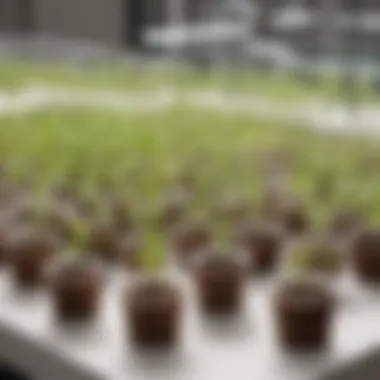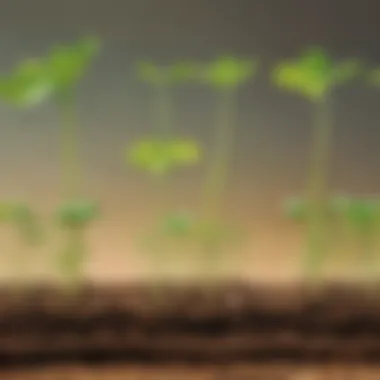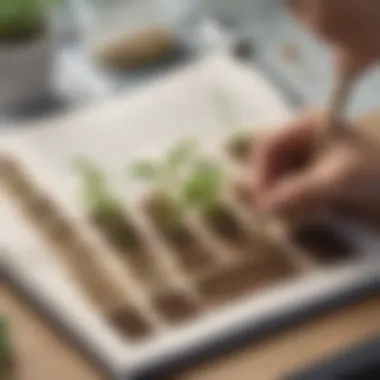Understanding Seed Germination Testing: A Comprehensive Guide


Intro
Seed germination testing is a vital aspect of understanding how seeds know the right time to sprout. It is key for farmers, gardeners, and scientists. By evaluating the germination process, they can judge the viability of seeds. This knowledge influences the choices they make in planting crops or caring for plants.
Seeds are unique. Each has its own way of responding to conditions like water, light and temperature. Timing is critical, since seeds also have a dormancy period. Understanding dormancy helps us know when to test germination.
Through this article, we will explore different methods of testing seed germination and why it is important. We will analyze various factors that can also influence germination. Learning this knowledge encourages us to appreciate the science behind farming and gardening.
Science Fun Facts
Germination is not just a simple sprouting process. It is an interesting chemical, physical and biological dance that seeds perform to begin their life. Here are some fun facts:
- Seeds can survive extremes: Some seeds can last for thousands of years in dry conditions. A seed found in an Arctic region was successfully germinated after 32,000 years.
- Temperature matters: Each type of seed has a preferred temperature range for germination. For instance, tomatoes thrive at around 70°F to 90°F.
- Light and darkness: Certain seeds, like lettuce, require light to germinate while others need complete darkness.
- Chemical communication: Seeds can react to signals from other plants to figure out the planted ecosystem.
Seeds are fascinating life forms, with traits that enable them to stay alive for long and sprout at the right moment.
“Understanding seed germination tests provides insight into not only plant growth but also ecosystems overall.”
The Significance of Testing Seeds
Testing seeds is essential for numerous reasons. Here are a few:
- Effective Planning: Germination tests help farmers select the best time to plant seeds, ensuring better yield.
- Cost Efficiency: Knowing which seeds are healthy and viable can save money. Responsible planting prevents wasted resources.
- Quality of Crop: By testing seeds, gardeners can select high-quality plants, leading to richer gardens and farmland.
Germination testing plays a key role alongside knowledge of seed anatomy.
Methods of Germination Testing
There are multiple approaches available for testing seed germination effectiveness. Some methods are simpler while others inlcude scientific afixtures. Below are common methods:
- Paper Towel Method: This popular technique involves placing seeds between damp paper towels. In a week, observe how many sprouted.
- Moist Soil Method: Plant seeds in moist soil in a pot. Monitor for germination over a few weeks.
- Germination Box: These are specially designed to facilitate seed germination. They come with specific environmental control.
Different methods suit diverse purposes. For home gardeners, the paper towel method is popular for simplicity. In agricultural settings, scientists may prefer precise equipment to analyze germination.
Factors Influencing Germination
In addition to seed type, many reasons can affect how well seeds sprout:
- Environmental Conditions: Temperature, moisture and soil type play significant roles in seed maturity.
- Age of the Seed: Fresh seeds typically germinate better than older ones.
- Seed Cover: Some seeds have tough outer shells that need to be broken or softened.
- Chemicals and Biological Agents: The presence of growth-inhibiting chemicals can hinder sprouting.
Each factor could influence potential growth, making testing and understanding crucial.
Troubleshooting Common Issues
It's important to identify challenges in seed germination. Here are some issues:
- No Germination: This may indicate poor quality seeds or the wrong time for planting.
- Uneven Sprouts: If some seeds grow but others do not, it could relate to soil conditions.
- Slow Germination: Slow growth might relate to changes in temperature or moisture.
Understanding these challenges aids in developing effective seed treatment strategies.
Culmination
Seed germination testing is a fundamental science. Understanding seeds and how they react to their environment helps enhance food production and garden success. This knowledge benefits both amateur gardeners and professional farmers alike.
Prolusion to Seed Germination Testing
Seed germination testing is crucial in understanding how seeds develop and thrive. For farmers and gardeners alike, these tests provide deep insights into seed viability and potential yields. Knowing how and when seeds germinate can influence planting decisions and crop success. This article intends to guide readers through seed germination testing, its techniques, and its relevance.
Definition and Importance
Seed germination testing involves evaluating seeds for their ability to sprout under specific conditions. This process is necessary because not all seeds are created equal. They may vary based on their maturity, genetics, and environmental experiences. Ensure careful evaluations through simple methods to determine whether seeds are suitable for planting. The importance of germination testing cannot be overstated as it directly correlates with agricultural productivity.
Reasons parents and caregivers should consider teaching kids about seed testing:
- Understanding plant life cycles
- Appreciating the role of seeds in the ecosystem
- Fostering scientific inquiry


Adequate knowledge about germination serves as a foundation for better gardening practices.
Applications in Agriculture and Horticulture
In agriculture, knowing the germination rate of seeds aids in better planning and optimization. Farmers can effectively determine optimal planting times, reduction in crop failures, and resource management. For commercial growers, seed tests ensure high-quality seedling production which translates directly into better produce.
In horticulture, gardening enthusiasts benefit from understanding germination as it informs them of which seeds may yield the best results in a specific environment. Techniques or choices of growing methods vary based on the needs of the plants. This way, and they maximize their success in their gardens.
Significant aspects of seed testing applications include:
- Evaluating seed sources
- Identifying high-quality seeds for specific projects
- Influencing decisions related to fertilizers and amendments
It's critical to realize that successful gardening and farming begin with healthy seeds. Germination rates directly impact future plant growth and fruit yield.
Understanding Seed Anatomy
Understanding seed anatomy is vital for grasping the fundamentals of seed germination testing. Each part of a seed plays a specific role in the development of a plant. Knowing the functions of these parts allows us to predict how seeds will react to various testing conditions. This knowledge is critical for anyone wishing to enhance seed viability and improve agricultural practices.
Parts of a Seed
A seed consists of several components crucial for its germination and growth. These parts include:
- Seed Coat: This is the protective outer layer of a seed. It guards against physical damage and environmental stress. The seed coat can vary in thickness and texture.
- Endosperm: This part contains food reserves for the developing plant. The endosperm supplies nutrients during germination, enabling the seedling to grow until it can produce its own food through photosynthesis.
- Embryo: The embryo is the actual young plant. It contains the key structures needed for future growth, including the roots, stem, and leaves. The health of the embryo is critical for successful germination.
Each of these parts interacts with environmental conditions to affect germination rates. For example, the moisture the seed absorbs breaks down the seed coat and allows access to the nutrients needed by the embryo.
Types of Seeds
Seeds can be classified into several categories based on their structure and features. Understanding these types can aid in effective testing and selection. The common types include:
- Dry Seeds: These seeds lack moisture and have developed hard coats. They are generally dormant until placed in suitable conditions.
- Wet Seeds: These seeds are already moist and might show signs of pre-germination. They require careful handling to prevent premature growth.
- Hard Seeds: Some seeds have extremely tough outer layers, which may require scarification to allow water to enter. Examples include برخی legume seeds.
- Soft Seeds: These seeds have delicate coats and can easily absorb water. They often require gentle handling.
Selection of the right type can significantly impact the success of germination testing. Choosing a seed type suitable for the environmental conditions is as important as using proper testing methods. Taking the time to learn these aspects enriches the understanding of seed biology.
Methods of Conducting Seed Germination Tests
Germination testing is vital for gardening and farming. The methods explained in this section help determine the seeds’ health. Knowing how seeds germinate allows growers to make informed decisions. It ensures optimal planting times and environments, maximizing the chances of successful plant growth. Each testing method has its strengths and weaknesses, making them suitable for different situations. Proper understanding and application of these methods can have a significant impact on crop yield.
Paper Towel Method
The paper towel method is a simple yet effective way to test seed germination. You only need damp paper towels, seeds, and a warm spot. First, moisten the paper towel. Then, lay the seeds on half the towel. Fold the other half over the seeds. Place the whole setup in a warm location. Check regularly for moisture. This method closely simulates natural conditions.
Key benefits include:
- Simple to perform, making it excellent for beginners.
- Minimal equipment needed; just common household items.
- Provides quick results, usually within a week.
This method gives a good indication of how well seeds can germinate before planting them outside.
Soil-Based Method
The soil-based method involves planting seeds directly into the soil. It reflects real gardening conditions and assesses how seeds react to soil environment. Start by filling pots with moist potting soil. Then, plant a few seeds in each pot at a consistent depth. Keep the pots in a warm, bright location. Regularly water them but avoid making the soil too soggy.
Advantages of the soil-based method are:
- Offers insights into seed growth under real conditions.
- Evaluates how well seeds interact with soil nutrients.
It can take longer to see results with this method, usually two to three weeks, but it provides valuable experience.
Water Test Method
The water test method is helpful for specific seeds, like beans and peas. This involves soaking sqeuentially before planting. Soak seeds in water for 24 hours. Enablefull saturation. Remove the seeds from water, then place them in a damp paper towel. Keep an eye and ensure the towel remains moist. This early soak can stimulate germination process.
Benefits of the water test method include:
- Focuses on seeds that require more moisture to germinate.
- Offers an easy observation to see how seeds swell before germination.
However, few seeds might be sensitive to being soaked too long, leading to problems. Therefore, avoid extended soaking times.


Overall, these methods give a wide array of options for testing seed germination. Understanding each one allows for informed choices. Testing methods can create a better experience for growers. Choosing the right approach is elemental for healthy plant growth.
Factors Affecting Seed Germination
Understanding what affects seed germination is key for anyone wanting to grow plants successfully. Many factors play a role in germination, and knowing how to manage these can significantly boost your chances of seed success. This section will explore four main elements: moisture levels, temperature conditions, light exposure, and seed age. Each factor holds its significance and can either enhance or hinder germination. Thus, being mindful of these elements can encourage healthy plant growth.
Moisture Levels
Moisture is perhaps the most crucial factor for seed germination. Seeds require enough water to begin the germination process. The right amount of moisture helps break down the seed coat and kickstarts the metabolic activities necessary for sprouting. When seeds are exposed to moisture, they absorb water in a process called imbibition. This is essential as it activates enzymes that support growth.
Too little moisture leads to seeds that stay dormant. High moisture can be equally problematic, resulting in rot or fungal diseases.
Key points to consider:
- Optimal Range: Different plant species have different moisture needs. Understanding specific seed requirements is vital.
- Water Quality: Use clean water, as contaminants may harm germination.
- Measurement: Aim to keep growing media consistently moist but not overly saturated.
Temperature Conditions
Temperature directly affects a seed's metabolic rate. Each seed has an ideal temperature range for optimal germination. When temperatures fall below or rise above this range, germination rates can decline significantly. For example, many spring vegetables need temperatures around 65°F to 75°F for effective sprouting.
Germination speeds can also vary. While warmer temperatures might result in quicker germination, extreme heat can cause damage. Conversely, cooler temperatures may lead to slower growth processes but can also extend dormancy in some seeds.
Critical aspects regarding temperature:
- Thermal Regulation: Consider providing gentle heat sources for cool-season crops.
- Weather Conditions: Be aware of local climate and average seasonal temperatures to select appropriate seeds.
- Stress Trials: Sometimes testing seeds at varying temperatures can yield insights about their durability.
Light Exposure
Light exposure may not seem critical, but it can significantly influence germination success. Some seeds require light to germinate, while others must remain in the dark. For example, lettuce seeds need exposure to light, yet carrots thrive in darkness during germination. Their physiological responses to light help them fit into various ecological niches.?
It’s important to understand the light needs of specific seeds:
- Photo-sensitivity: Know the requirements of each plant species.
- Artificial Lighting: In limited sunlight, artificial sources like fluorescent bulbs can help.
- Timing of Exposure: Ensure seeds are given the correct light conditions necessary as they start to grow.
Seed Age and Viability
Lastly, seed age plays a critical role in germination rates. Most seeds maintain viability for several years if stored correctly. However, over time, seeds lose their ability to sprout effectively. The factors such as temperature, humidity, and light exposure during storage can affect the lifespan of seeds.
It's essential to check the dates on seed packets and perform germination tests on older seeds to ascertain viability. Maintaining seeds in cool, dark, and dry environments extends their life-span. Generally, the steeper the age, the greater the chance of poor germination rates.
Key factors regarding seed age include:
- Storage: Store seeds properly to prolong viability.
- Germination Tests: Perform simple tests to confirm roots are still alive.
- Replacement Stocks: It's wise to renew your seeds regularly for optimum results.
Seeds themselves contain a wealth of potential. But careful management of the factors that influence their germination ensures their promise bears fruit.
Interpreting Seed Germination Results
Interpreting seed germination results is crucial for understanding the effectiveness of your seed testing efforts. Accurate interpretation leads to better insights into seed viability, which is essential for successful planting in agriculture and gardening. By analyzing results, one can evaluate what conditions promote or hinder germination. This section will explore the significance of germination rate calculation and the understanding of seedling development.
Germination Rate Calculation
Calculating the germination rate provides a quantitative measure of how many seeds are capable of sprouting under tested conditions. The process typically follows this simple formula:
Germination Rate (%) = (Number of Seeds Germinated / Total Number of Seeds Tested) * 100
The results should be easy to interpret. For example, if ten seeds were germinated and a total of twenty were tested, the calculation would yield:
d = (10/20) * 100, which is 50%.
A 50% germination rate indicates that half of the tested seeds can successfully sprout. High germination rates often suggest that seeds are fresh and viable. In contrast, low rates may signal problems with seed age or storage conditions.
Additional elements to consider while calculating germination rates:
- Testing Conditions: Ensure consistent moisture and temperature throughout the test.
- Duration: Take results after a sufficient time has passed, typically the time indicated for each seed's species.


Accurate measurements and observations in this stage aid in identifying trends across different seed varieties. When documented carefully, such evaluations lead to informed decisions in future planting practices.
Understanding Seedling Development
Understanding seedling development is another significant aspect of interpreting seed germination results. This phase covers the growth process from germination to the establishment of healthy seedlings. Determining the factors that contribute to robust seedling growth is critical. Here are key stages and elements:
- Germination: During germination, the seed absorbs water, causing it to swell. The seed coat weakens, allowing the embryo to emerge.
- Vegetative Growth: After germination, seedlings begin to develop leaves and roots. Sufficient light, warmth, and nutrients are essential during this period to ensure successful growth.
- Establishment: Once seedlings take root, ongoing care is needed for continued health. The right pH levels and nutrient availability foster this establishment period.
Important considerations for favorable seedling development include:
- Striking a balance between light exposure and moisture levels
- Protecting young seedlings from pest attacks
- Observing how various environmental factors influence growth
To summarize, by interpreting germination results effectively, one not only assesses seed viability but also understands ongoing expects during the initial stages of plant development.
Common Issues in Seed Germination Testing
Examining potential problems in seed germination testing is essential. By understanding these issues, one can greatly improve the testing process, leading to better outcomes. Poor germination rates and the presence of mold or diseases are two significant concerns. Addressing them benefits both practitioners and the entire cycle of plant growth. This discussion uncovers the root causes of these challenges and offers insight into managing them.
Practical Tips for Successful Seed Germination Testing
Seed germination testing holds significant role in ensuring an effective planting process. Having reliable and successful testing not only promotes a positive growing experience but also contributes to sustainable agriculture. Understanding and implementing practical tips can directly influence the success rate of germination, helping to improve the quality of plants produced. This section expands on two fundamental elements: selecting the right seeds and creating an optimal environment for germination.
Selecting the Right Seeds
When it comes to seed germination, choosing the right seeds is critically important. Opting for quality seeds can set the stage for favorable growth outcomes. Consider the following:
- Source of Seeds: Imagine trusting well-known suppliers instead of unknown ones. Seeds from reputable garden centers or suppliers often have higher viability rates.
- Check Expiration Dates: Always check the packaging for valid expiration or best-before dates.
- Seed Type: Specific plants demand particular growth conditions. Therefore, familiarize yourself with seeds that suit the local climate or to be grown indoors or outdoors. Opt for seeds known for robust germination rates. Good examples are lettuce, beans, and peas.
- Local Adaptation: Consider local varieties that are adapted to environmental conditions. These seeds often confer better resistance to local pests and diseases.
Selecting the right seeds enhances the likelihood of successful germination and stands as the first step to gardening to go smooth.
Creating an Optimal Environment
For seeds to germinate, the environment plays a key role. Here are basic details to consider:
- Moisture Levels: Keep seeds consistently moist yet not flooded. A paper towel method proves this well. Wrapping seeds in damp paper towels helps maintain moisture. Just monitor them daily.
- Temperature: Seeds require warmth for germination. Different seeds have specific temperature ranges. For most, an ambient temperature between 65°F to 75°F helps initiate the process.
- Light Needs: Some seeds are photoblastic, needing light to germinate. Understand those conditions. For example, petunias require light, while other seeds can be placed in darkness.
- Air Circulation: Seeds need oxygen for proper germination. Ensure spaces around germination containers are well ventilated to promote an undisturbed growth.
- Containers: Choose containers appropriately sized for the seeds. Avoid tiny pots if their root systems are extensive. Select sizes that allow for healthy growth without making them cramped.
Creating an optimal environment helps streamline the germination process. Extra care in this stage helps settle the foundation for young plants.
Remember: The right seed combined with the ideal environment is essential for effective germination testing. Each step can either hinder or boost the chances significantly.
With these practical tips in mind, embarking on seed germination testing becomes a smoother and more rewarding journey.
Ethical Considerations in Seed Testing
Understanding the ethics of seed testing is vital. Farmers and researchers must recognize their responsibilities in ensuring sustainable practices. This responsibility includes recognizing the potential consequences for ecosystems while enhancing agricultural productivity.
Sustainable Practices
Sustainable practices in seed testing revolve around minimizing environmental impact. Reducing chemical usage and adopting organic methods are crucial elements. Seed testers ought to embrace environmentally-friendly techniques that promote healthy soil and ecosystems.
Additionally, understanding how seeds interact with their environments plays a key role. Seeds should be sourced and tested in a manner that respects local biodiversity. Practical action can include:
- Using native seeds.
- Ensuring land diversity remains unharmed during exploration.
- Collaborating with local communities for ethically sourcing seeds.
“All efforts in seed testing should consider ecological implication, as this advances sustainability in agriculture.
Finale and Future Directions
In our rapidly changing world, the study of seed germination testing holds significant relevance for the future of agriculture and environmental sustainability. Understanding how seeds germinate directly correlates with food production, plant conservation, and ecosystem health. This article has elaborated on various aspects of seed germination such as methods of testing, factors influencing success rates, and ethical considerations we ought to keep in mind.
The conclusion serves not just to recap vital information but also to navigate future directions in research pertaining to seed germination. As global warming and urbanization pose new challenges, our techniques may need adaptation or enhancement. Emerging technologies, such as artificial intelligence and precision agriculture, may transform how we experiment with and understand seed viability.
The Importance of Ongoing Research
Ongoing scientific research is crucial in making advancements in seed germination testing. Follow these important points on research focus:
- Enhancing Testing Methods: Research aims to discover possibly innovative methods to improve accuracy and efficiency. Simple adjustments may yield significant differences in results.
- Biodiversity and Conservation: Understanding seed viability in various environmental conditions is an important aspect of preserving different species. Continuous research helps develop strategies for conservation.
- Response to Environmental Changes: Studies are needed to predict how seeds react to climate variability, allowing better preparedness in agriculture and horticulture.
- Educational Impacts: Ongoing research fosters a more well-informed public. Children, parents, and educators benefit especially from aknowledging simple experiments diverse teachers provide.
Investing in this research will benefit all; from farmers needing reliable crops to environmentalists working towards flora preservation. Continuous inquiries carry the potential for us to unlock even greater information and lead to breakthroughs that help overcome obstacles present today. This focused dedication to ongoing research guarantees developments in food production and environmental conservation adaptive to our ever-changing world.
"The continued exploration of seed germination testing can illuminate pathways that improve both our agricultural practices and environmental health."
Pursuing this path will result in a deeper understanding and meaningful approaches that positively contribute towards a sustainable future for generations to come.







